
|
|
|
|
|
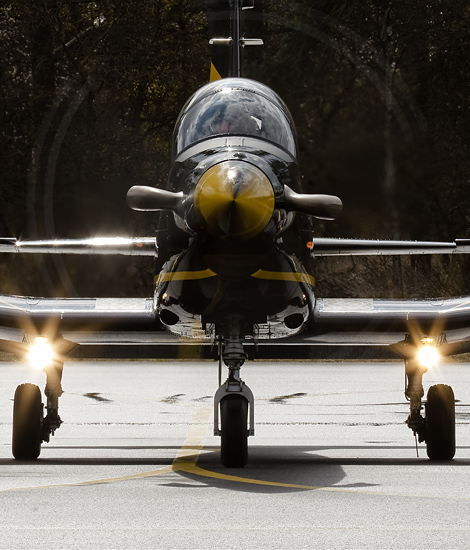
|
The Pilatus PC-7 Turbo Trainer; Woensdrecht, April 15, 2008
Training with the no 131 EMVO Squadron; Text and Photograph’s by Alex van Noye
On Tuesday, April 15, 2008, I was welcome at Woensdrecht Air Base. I would visit the no 131 EMVO Squadron during
this relatively short base visit. This unit is equipped with the Pilatus PC-7 Turbo Trainer. The unit is responsible
for the basic pilot training of the Royal Netherlands Air Force.
The Pilatus PC-7 Turbo Trainer is a two-seat training aircraft with a low wing configuration. The aircraft was
built by the Pilatus Company from Switzerland. The aircraft can be used for various training tasks, such as;
basic training maneuvers, training of aerobatics, instrument flying training and tactical flying training. The
airplane can be used during night and day time. More than 20 countries are using the PC-7 in the role of training
aircraft. More than 500 PC-7s were built since 1978 and the majority of these planes are still in service. The
development of the PC-7 was based on the piston engine powered Pilatus P-3. The first prototype flew on April 12,
1966. The aircraft was compared with the prototype of the P-3 modified with the Lycoming O-435 engine which replaced
the Pratt & Whitney PT6A-20 turboprop. The program was delayed when the prototype crashed. The program was continued
since Pilatus received another P-3 from the Swiss Air Force. The aircraft flew for the first time on May 12, 1975.
The design was further modified; the aircraft received a new wing design with integral fuel tanks and a modified
tail fin. The first production aircraft flew on August 12, 1978. The Swiss civil certification followed on December
5 in the same year. The aircraft was also immediately delivered to Burma and Bolivia. The aircraft became later a
success in the role of training aircraft.
The PC-7 Mk II was developed from components of the PC-7 and the newer PC-9. The airframe and the avionics were
used from the PC-9 design. The PC-7 Mk II is equipped with a smaller turbine engine which will keep the maintenance
costs much lower. This aircraft is used by the South African Air Force; they fly 60 of these aircraft. The aircraft
were delivered by Pilatus as kits and assembled in South Africa. The PC-7 Mk II is a specially designed variant for
the South African Air Force. The aircraft was because of political considerations also equipped with hardpoints
under the wings. Four PC-7 Mk II aircraft are in use at the air force of Brunei. The aircraft is used during
|
|
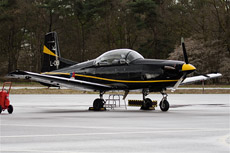
|
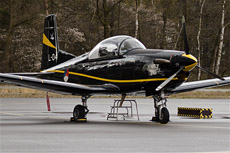
|
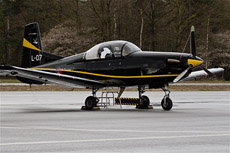
|
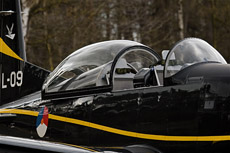
|
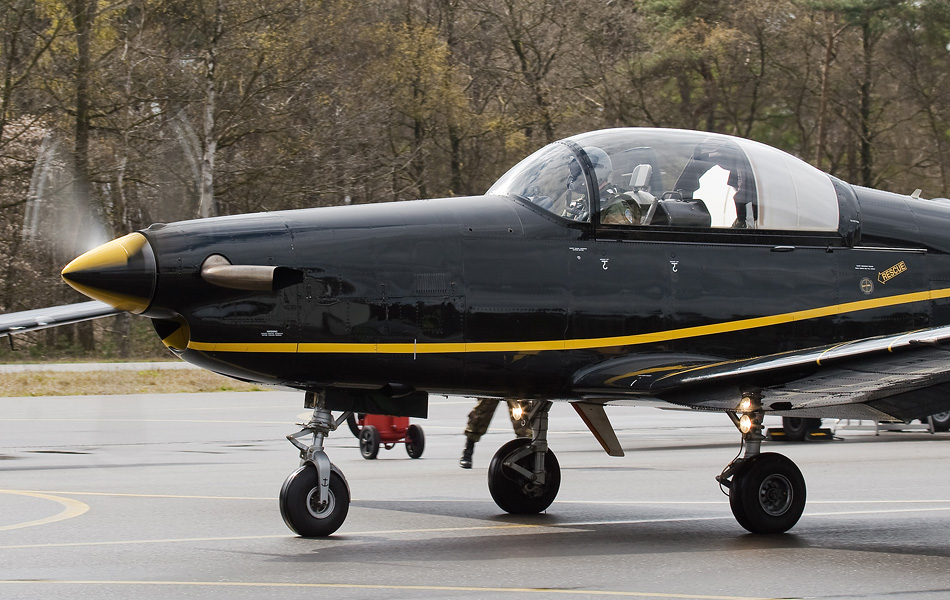
|
several conflicts. The PC-7 was used by the Iraqi Air Force for close air support during the Iran-Iraq war. They
were also used to drop chemical weapons on Iranian troops. The Chadian Air Force bombed rebels in their own country
and in Sudan with its small fleet of PC-7s. In 1994, armed PC-7s of the Mexican Air Force were used to attack
the Zapatista Army of the National Liberation Army during the conflict in Chiapas, Mexico. All these actions
were considered as illegal by the manufacturer, because the planes were sold as aircraft for training purposes.
Pilatus stopped the delivery of the PC-7 to these countries.
The Royal Netherlands Air Force is using the PC-7 since 1989 for the basic flight training of its pilots. There
were a total of 13 aircraft purchased. All the aircraft are based at Woensdrecht Air Base in the south of the
Netherlands. The PC-7s in the Netherlands are assigned to the no 131 EMVO Squadron. The acronym EMVO stands for
Elementaire Militaire Vlieger Opleiding (Elementary Military Pilot Training). The Dutch PC-7s were originally
painted in a yellow-white-red color scheme. This yellow color scheme is also the original color scheme of the
Pilatus factory. Research by TNO has shown that the aircraft will be more visible in Dutch airspace if they were
black. From a flight safety point of view this dark color scheme was chosen. The PC-7s of the Royal Netherlands
Air Force are all painted glossy black since 2005. The Dutch air force has a PC-7 Solo Display Team which
operates with 2 aircraft. The team has one operational aircraft and one spare aircraft. This team flies at
various airshows in Europe. The main airshow for this team are of course the Air Force Days every year somewhere
on a Dutch airbase.
We had to report ourselves at 9 am at the main gate of Woensdrecht Air Base. We were received in the base
information center. Our guide gave us a short introduction and we started the tour over the airbase by bus.
The only visit on the plan was a visit to the no 131 EMVO Squadron. The other locations at Woensdrecht were
not accessible to us. This was not a problem, because I came to Woensdrecht for the PC-7. It was already a
while ago that I had photographed these small training aircraft. The last time I had seen them was in the
period when they were still yellow. The weather today was also good. The sun was shining and it was not too
hot. Once we arrived on the platform I saw 3 PC-7s on the platform of the 131 ramp. We had bad luck, because
it is normal to catch at least 6 aircraft in common situations. We were able to shoot many photos from different
angles of these planes. There were a number of students at the EMVO platform. It was clear they were preparing
a training flight. We were initially photographing the planes at their parking spots. It soon became clear that
the 3 PC-7s would leave for a training flight within 15 minutes. The PC-7 in the middle was the first aircraft
which was prepared for take-off. The student checked the plane together with his instructor. The PC-7 was started
after a short check of the aircraft. I had my tripod with me and therefore I was able to shoot the aircraft
with long shutter speeds. This brought me a nice effect on the moving propeller blades. The machine rolled
along us to the taxi track at the end of the platform. The other 2 PC-7s were also prepared for a flight after
the departure of the first PC-7. These aircraft were started within several minutes. The most left plane was
the first aircraft which started to taxi. This aircraft taxied towards me with its landing lights on. This
brought me some nice photos. The aircraft had a beautiful reflection of the sun on its fuselage when it
turned towards the taxi track. Many stars were formed by the reflected light because of the bolds on the
metal plates of the aircraft. The third PC-7 left the platform in the same direction as the other 2. My short
visit at Woensdrecht was over after the departure of the last PC-7. It was a small visit which resulted in a
few remarkable photos.
|
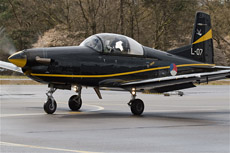
|
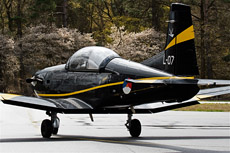
|
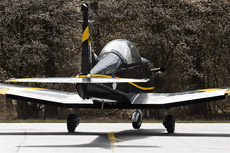
|
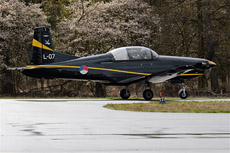
|
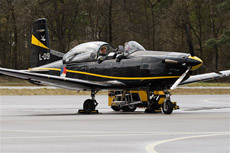
|
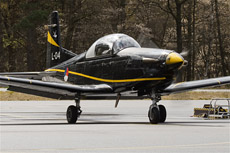
|
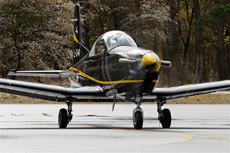
|
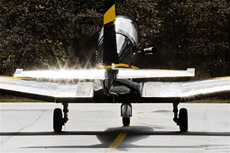
|
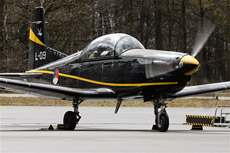
|
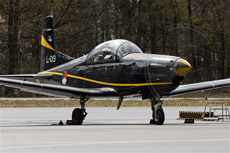
|
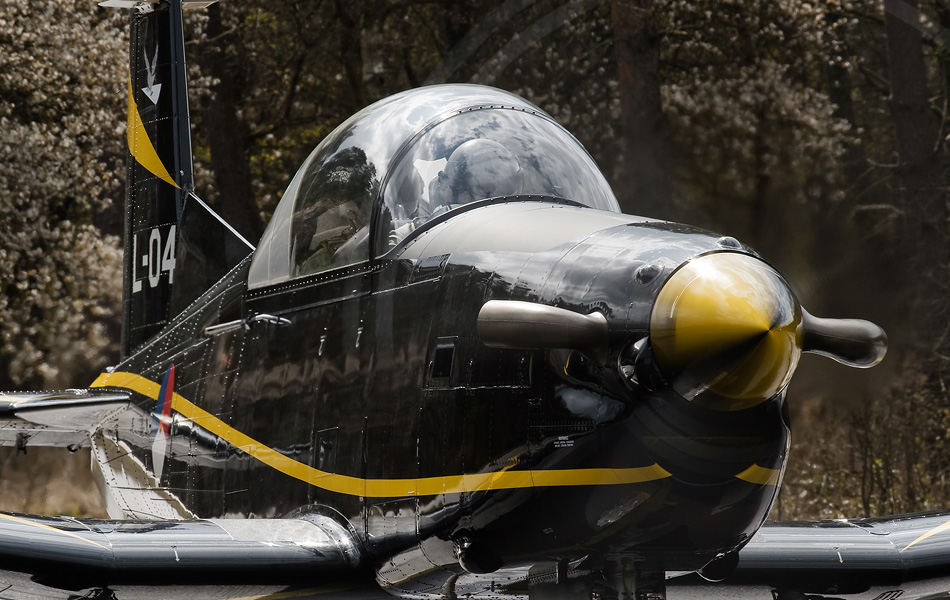
|
|
|

|







